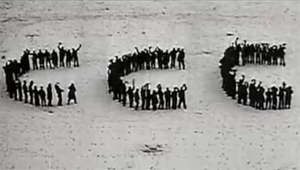The Evolution of the CCC
1881: Early History
The Department of Agriculture creates a separate division of forestry to address management policies of the nation’s forests.
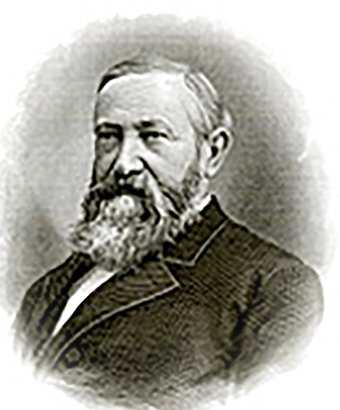
March 3, 1891
The Forest Reserve Act allows President Benjamin Harrison to create 17 forest reserves over the next three years. This is in stark contrast to the government’s longstanding push towards privatization of land.
1907
The U.S. Forest Service takes control of the forest reserves, now known as National Forests.
1910
A 19-year old Franklin Delano Roosevelt takes control of his family estate in Hyde Park, NY. To help fix a visible erosion problem he will plant thousands of trees across the property.
March 1, 1911
The Weeks Law allows the Forest Service to purchase land from private owners — primarily on the East Coast — in order to preserve watersheds.
1921
Only 19 states have any kind of state park system. Within the next four years all U.S. states will have park systems in development, but financial strain during the Great Depression will ultimately push most of those plans to the back burner.
1929: Combining Reforestation and Work Relief
New York State Governor Franklin Roosevelt passes a law to aid in county- and state-wide reforestation.
After the decade-long boom of the Roaring 20s, unemployment is roughly 3%. People will continue to have faith in the economy until the Crash of 1929 in October.
1930
New York state legislature approves a plan to purchase abandoned or neglected farmlands for reforestation. In the next year, New York will set up a temporary emergency relief administration that hires unemployed workers to improve forest conditions and create recreational facilities for the public.
1932
The state of California has 1,500 unemployed men working on reforestation and land improvement projects. They live in 25 camps across the state. Pennsylvania, Wisconsin, Michigan, Washington, Virginia and Indiana have similar plans in the works.
July 2, 1932
In his acceptance speech for the Democratic nominee for president, FDR touts a “plan of converting many millions of acres of marginal and unused land into timber land through reforestation.”
November 1932
Roosevelt wins the presidential election in a landslide, carrying all but six states.
December 1932
Mississippi submits a plan for the government to buy one million acres in each southern state that would then be reforested and improved by young men between 18 and 30 years old. These men would receive $1 per day to build roads, trails, dams and firebreaks.
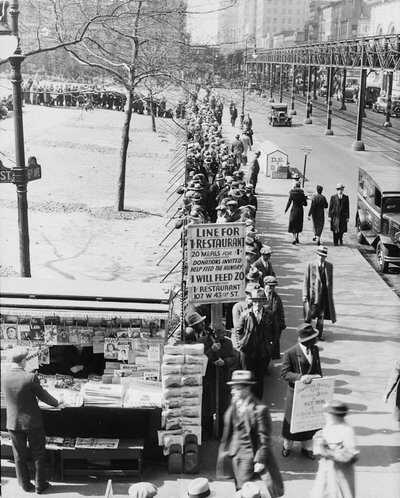
1933
The U.S. is in the throes of the Great Depression. Unemployment will reach up to 25% this year.
March 4
FDR takes the oath of office.
March 9
President Roosevelt calls several department heads together to draw up a bill outlining a conservation work program to involve half a million young men between 18-25 years old.
March 31
President Roosevelt signs the Federal Unemployment Relief Act into law, calling for the program to begin in two weeks. Enrollment is limited to unmarried, unemployed, healthy young men 18-23 years of age (though this will change). Policy dictates that discrimination by race, creed or politics is not allowed.
The program is commonly called the Civilian Conservation Corps, or the CCC.
April 5
Five days after being signed into law, the CCC program has signed up 25,000 men from 16 cities.
April 14
To meet Roosevelt's goal of 250,000 men at work by July 1, the Forest Service and Park Service open enrollment to American Indians, who are typically not required to stay overnight in the camps. Over 80,000 Native Americans will serve in the CCC.
April 17
Camp Roosevelt opens with Henry Rich of Alexandria, VA, as the first enrollee.
April 22
CCC enrollment opens to locally employed men who do not have to meet the marriage and age stipulations.
A few weeks later enrollment will open to WWI veterans. These men, now in their 30’s and 40’s, will live in special camps where rules are slightly more lenient.
June
The CCC offers evening educational programs to all enrollees, and more than 90% will participate in some way.
Over the nine-year course of the CCC, over 40,000 illiterate men will be taught to read and write.
June 11
Camp commanders are allowed to select a few men to act as camp leaders, working some administrative tasks and overseeing projects. These leaders will receive an extra $15 a month. Commanders can also choose assistant leaders, who would make $6 extra per month.
July
Charlie Lord leads a crew of 25 men to Mount Mansfield in Stowe, VT to cut Bruce Trail. The following winter (February 1934) Mt. Mansfield will hold its first downhill ski race. CCC crews will continue to cut more trails which will eventually become the nucleus of the Stowe ski resort.
July 1
There are 34,000 enrollees working in 172 camps in 35 states across the United States. By September, the number of camps across the country will rise to 1,468.
August 12
President Roosevelt visits CCC camps in Shenandoah Valley to publicize the program’s success.
December
The Winooski River Valley in Vermont is home to the largest concentration of CCC personnel, with 5,300 men in four large camps.
January: 1934
Hawaii National Park enrolls men into its first CCC camp. These men are allowed to live either at the camp or at their homes.
Summer
The President and his family visit camps in Glacier and Hawaii National Parks.
The Park Service estimates the value of work in all the State Parks at over $27 million for the first two years of the program alone. By 1935 they would deduce that the CCC had advanced forestry and park development by as much as two decades.
September 10
Robert Collins, an adjunct general in the War Department, sends a memo stating, “In the future, segregation of colored men by company, while not mandatory, will be the general rule and earnest effort will be made to reduce the total number of colored men in white units….”
December 6
CCC camps open in the territory of the U.S. Virgin Islands and include 160 enrollees from St. Croix and St. Thomas who work on forestry projects.
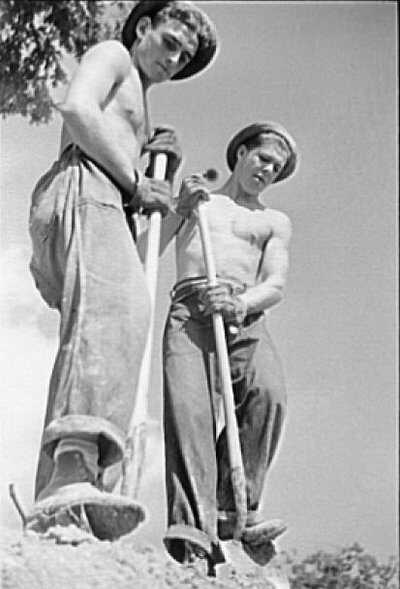
1935: 1935
This year will see enrollment peak, with 500,000 men located in 2,600 operating camps in all states.
California alone will have over 150 camps.
April 8
The Emergency Relief Appropriation Act extends the CCC through March 1937. Two days later, President Roosevelt doubles the enrollment goal to 600,000 and broadens the age range to 17 – 28 years.
July
After receiving complaints from residents of towns near mixed-race camps, CCC Director Robert Fechner orders “complete segregation of colored and white enrollees.”
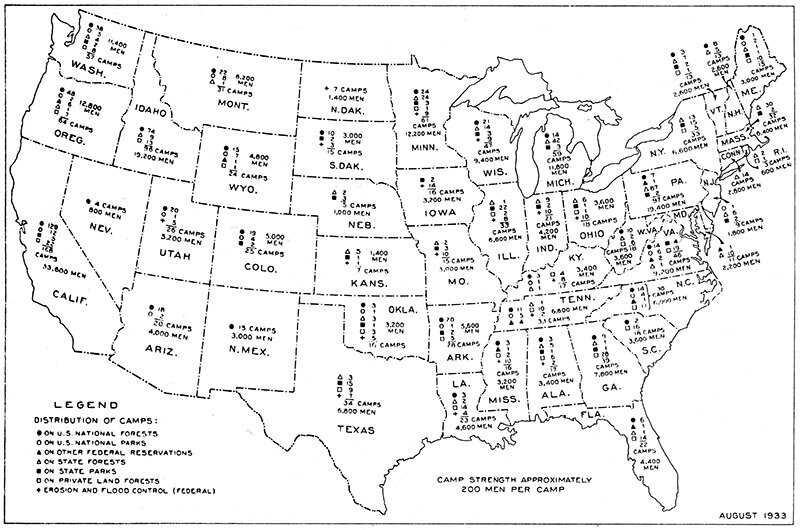
September 25
There are 2,635 CCC camps across the U.S. President Roosevelt directs Robert Fechner to begin reducing the number of enrollees by June 1, 1938. His goal is to shrink the size of the CCC in order to make it a permanent organization.
September 27
President Roosevelt orders Robert Fechner to appoint black supervisors at the African American CCC camps. But after meeting resistance from southern congressmen, FDR will rescind the order within a few days.
November 24
A CCC company in Washington State made up of 196 Massachusetts men sends a telegram to Director Fechner protesting a segregation policy that has ordered six of their black camp-mates back to their home state. No definitive record exists of the outcome, but a communication the following day implies the segregation will be enforced.
1936
CCC boys will help flood victims in Maryland, Pennsylvania and Washington, DC this year. They also help tornado victims in Georgia and Alabama, and they assist with flood mitigation and cleanup in Tennessee and Arkansas.
June 5
Virginia’s state park system launches with the opening of six CCC-created parks.
July 3
President Roosevelt dedicates Shenandoah National Park, and he suggests his intention for a permanent conservation program.
October 7
Jefferson National Forest in Virginia gains 673 acres with $60,000 of CCC funds.
Over the course of the program, the state of Virginia gained nearly 700,000 acres of new national forest land. Its proximity to Washington, DC and other major metropolitan areas helped the state garner many benefits from the program.
April 1, 1937: The Late 1930s
The CCC program in Alaska is nearly doubled, and about half of the new enrollees are required to be native Alaskans.
April 27, 1937
Reno Stitely, chief of the voucher unit, is arrested for embezzling nearly $85,000 in fake payroll vouchers. Though the fraud is isolated, the case will receive a lot of attention and become quite sensationalized in the press.
June 28, 1937
Extended for three more years, the Emergency Conservation Work, as it has been officially titled since its inception, formally becomes the Civilian Conservation Corps. The President's effort to make it a permanent government agency does not pass, but there is a new provision dedicating 10 hours a week to general education and vocational training.
1938
Thus far, the CCC boys have developed over three million acres for park use in 854 state parks. Visitation to some parks has jumped as high as 500%.
July 1938
With the Great Depression slowly ending, more men now can get better-paying jobs at home. The average number of men per CCC camp is down to 142. This is well below Roosevelt's original goal of 200.
February 8, 1939
A special investigation at Camp Pena Blanca in Arizona concludes that several men from Pennsylvania had joined the CCC in order to get a 'free’ ride West. That includes nine men who had been dishonorably discharged for refusing to work – something they did in order to be released from the CCC. Desertion rates will reach almost 20% in 1939, up from 8% in 1933.
June 1, 1939
King George VI of Great Britain tours CCC camps in Virginia.
August 31, 1939
Germany invades Poland. Canada and much of Europe will declare war within a matter of days.
December 31, 1939: The Program Winds Down
Director Robert Fechner dies from complications following a heart attack. His replacement, James McEntee, faces several serious challenges as the CCC's budget has been slashed over the past few years. The improving economy is resulting in fewer recruits and a higher rate of desertion, as young men no longer need the $1 per day.
1940
Gettysburg National Military park becomes the first (of two) all-black camp when the remaining white supervisors are replaced with African Americans.
June 1940
France falls to Germany in WWII. President Roosevelt allows CCC camps on military bases where enrollees build military structures, airfields, obstacle courses, artillery ranges and training fields. The CCC has expanded the educational programs to include engineering, blueprint reading and other defense-related skills.
January 1, 1941
To retain enrollees, the CCC allows them to receive $8 per month in cash with only $15 being sent home. The remaining $7 is placed in a savings account until the enrollee’s honorable discharge.
June 14, 1941
At Natural Bridge Camp in Virginia, enrollees at a veteran camp are showing lack of discipline. An agent from the Department of Justice goes undercover as a CCC worker and catches illicit moonshiners selling liquor at the camp.
August 16, 1941
All CCC enrollees now drill in simple military formations. While the government does not issue arms to the civilians, the CCC boys now spend 20 hours a week doing general defense training.
September 1941
With most able young men now enlisting in the Armed Services, the CCC is further reduced to a total of 900 camps. Any camp that cannot maintain a minimum of 165 working men is closed.
December 7, 1941
The U.S. enters WWII after the bombing of Pearl Harbor. Later that month, Director McEntee decides to close all camps that do not directly relate to the war effort by May 1942.
January 1, 1942
The number of CCC camps in the U.S. is down to 800.
July 1, 1942
Although the program will never be officially terminated, the House and Senate approve funding to cover the costs of shutting down the remaining CCC camps and divvying up its equipment and resources.




